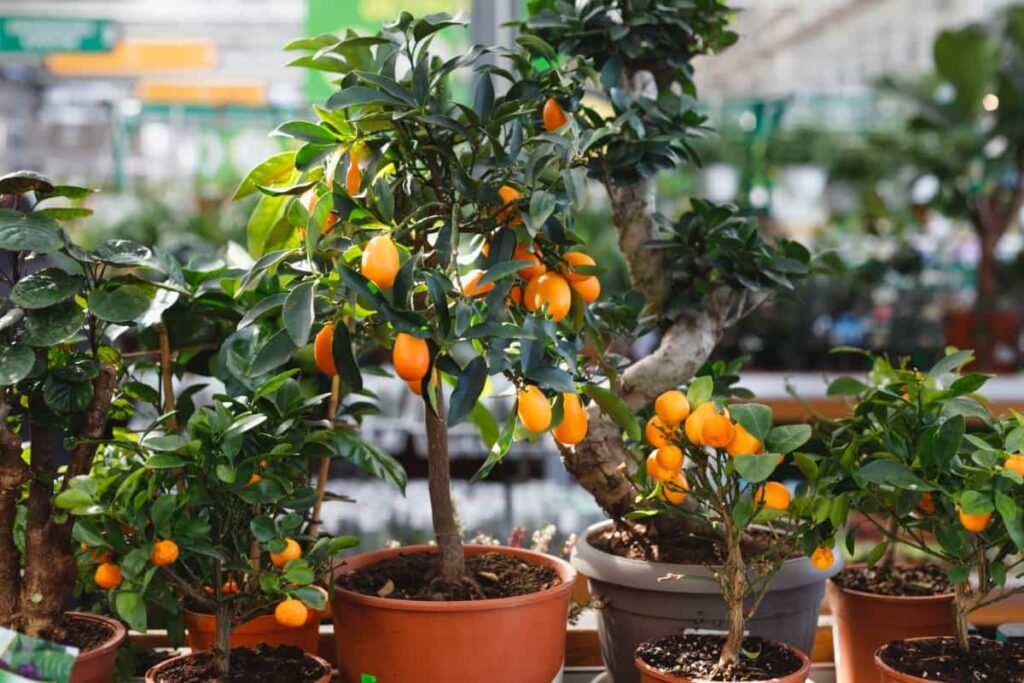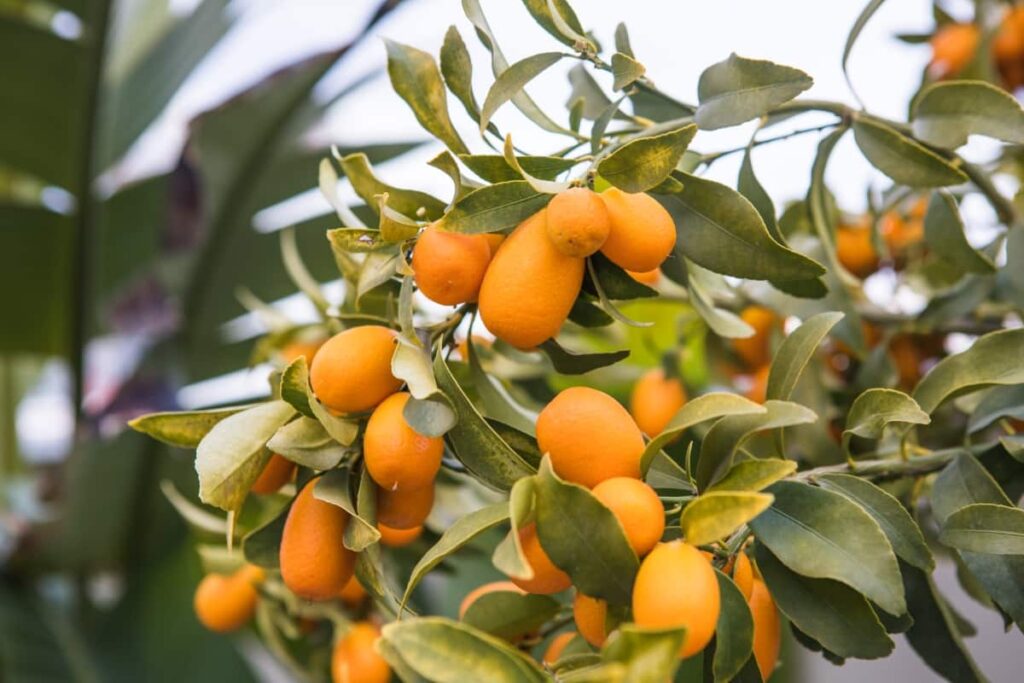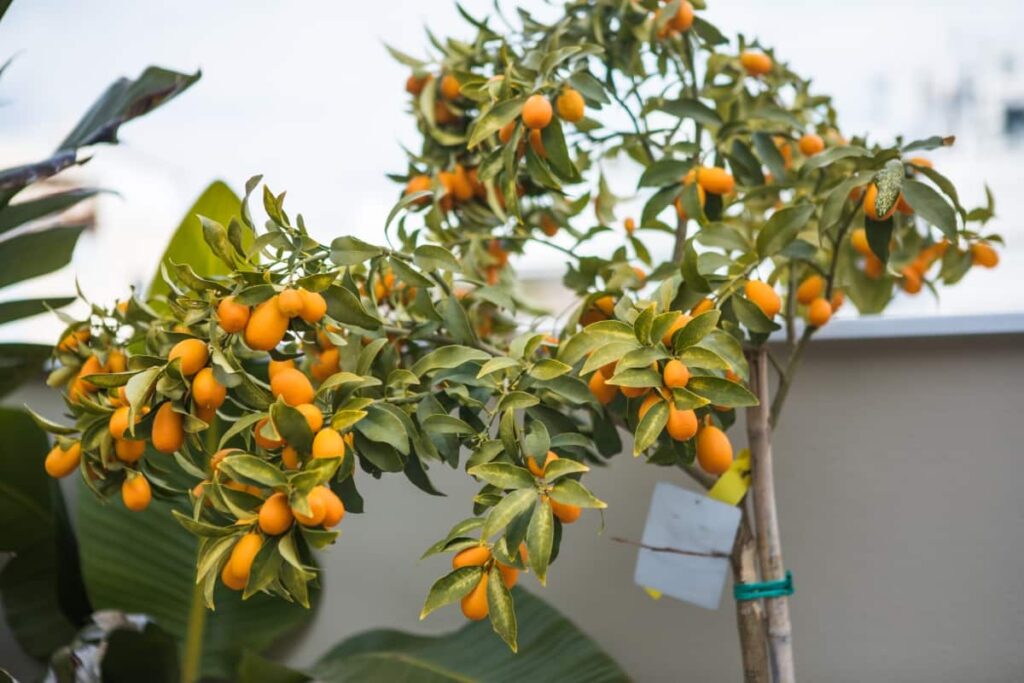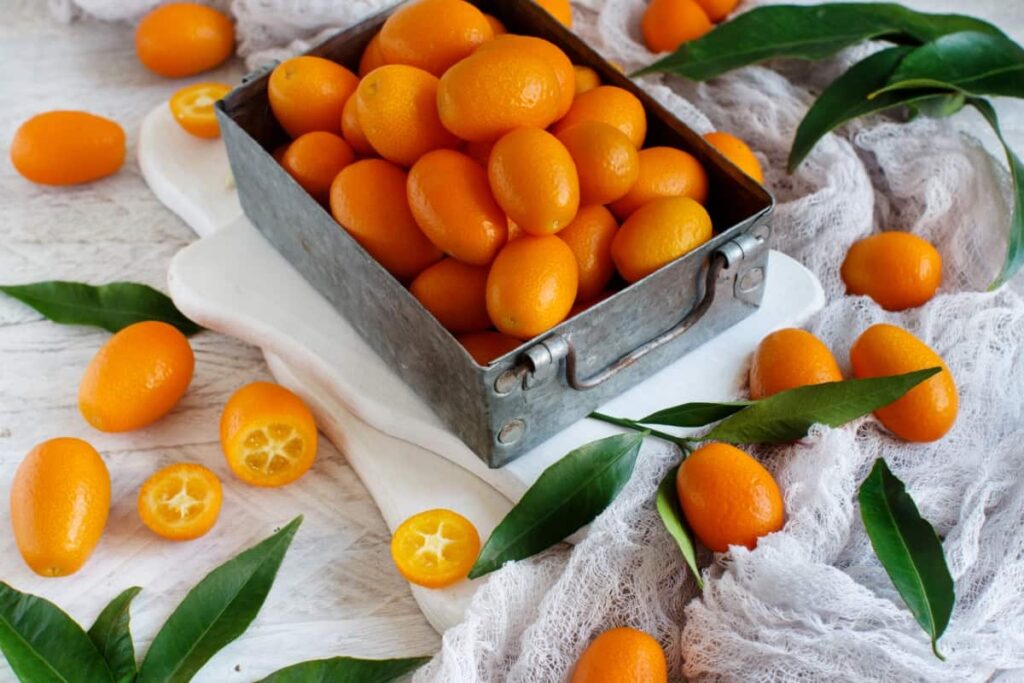Kumquat, a fascinating fruit, is a member of the genus Fortunella. These evergreen shrubs or trees belong to the family Rutaceae and are cherished for their unique tart orange fruits. These small, tart orange fruits are delicious and also incredibly easy to grow in pots.

How to Plant Kumquat in Pots
Best Soil Mix for Healthy Potted Kumquat Trees
The right soil composition can greatly impact the growth and overall health of your plants. For optimal results, it’s best to use a well-draining soil mix that allows for proper water drainage. A good soil mix option is a mixture of potting soil, perlite or sand, and organic matter like compost or peat moss. Potting soil provides essential nutrients and helps retain water, while perlite or sand improves drainage and prevents waterlogging. Adding organic matter enhances nutrient availability and promotes root development.
To create the soil mix, combine equal parts potting soil and perlite/sand with a generous amount (about 20-30%) of organic matter. Mix everything thoroughly before filling your pots. Remember to choose a high-quality potting mix without any added chemicals or synthetic fertilizers. Organic options are often preferred as they are free from harmful additives that may negatively affect plant health in the long run.
Sunlight and Watering Requirements for Potted Kumquat Trees
These citrus trees thrive in full sunlight, so it’s essential to place your pot in a location that receives at least six hours of direct sunlight each day. When it comes to watering, Kumquats have specific requirements. They prefer evenly moist soil but can’t tolerate waterlogged conditions.
Winter Care Strategies for in Pots
The winter season can be challenging for potted Kumquat trees, as they are sensitive to cold temperatures. However, with proper care and attention, you can ensure that your Kumquat tree survives the winter months and thrives come springtime. One important strategy is to protect from frost. Frost can damage the delicate leaves and branches of your Kumquat tree. To prevent this, you can cover your tree with a frost blanket or move it indoors if possible.
Another key consideration is watering. During the winter months, it’s important to reduce watering frequency as the tree’s growth slows down. Overwatering the Kumquat tree can lead to root rot and other issues. Instead, water sparingly but make sure the soil doesn’t completely dry out. Additionally, providing adequate sunlight is crucial during winter.
Pot Size Requirement for Kumquat Trees
Choosing the right pot size is crucial when it comes to growing Kumquat trees in containers. The pot size directly affects the growth and overall health of the tree. For young Kumquat trees, a small pot with a diameter of around 8-10 inches is sufficient. This allows the roots to establish themselves without being overwhelmed by too much space.
In case you missed it: How to Grow Kumquat from Seeds and Cuttings: Check How this Guide Helps Beginners

As the tree grows, it will need to be repotted into larger pots every couple of years. As a mature tree, a Kumquat requires a larger container, typically one that has a diameter of at least 18-20 inches. This ensures that there is enough room for proper root development and allows for better nutrient absorption from the soil.
Propagation from Seed or Cuttings
When it comes to propagating Kumquat from seeds, it’s essential to use fresh ones and soak them in water for about 24 hours before planting. This helps soften their outer shell and increases germination rates. Plant the seeds in a soil mix, ensuring they are covered by approximately half an inch of soil. Keep them consistently moist and place them in a warm location with indirect sunlight.
If you prefer propagating Kumquat from cuttings, select healthy stems that are around six inches long and have several leaves attached. Remove any flowers or buds to encourage root development. Dip the cutting into rooting hormone powder for better success rates, then insert it into a small pot filled with moistened soil mix.
Place the cutting in a bright but shaded area, misting regularly to maintain humidity levels. Both methods require patience, as germination or rooting can take several weeks or even months. However, once successful, you’ll have new Kumquat plants ready to be potted up and nurtured into thriving additions to your garden.
Pruning Procedure for Kumquat trees in pots
Pruning is a major aspect of maintaining the health and shape of your Kumquat tree when grown in a pot. To begin with, it’s important to prune your potted Kumquat tree during its dormant period, which is typically in late winter or early spring. Start tree pruning by removing any dead or diseased branches using sharp pruning shears. This will help to prevent the spread of diseases.
When it comes to shaping your Kumquat tree, aim for an open vase-like structure with several main scaffold branches radiating from the central trunk. This will ensure that light can penetrate through the canopy and encourage healthy growth throughout. Regularly monitor your potted Kumquat tree throughout the growing season and prune it as needed to maintain its shape and size.
Common Problems with Potted Kumquats
Pest Infestation: One of the most common problems faced by potted Kumquat trees is pest infestation. Aphids and spider mites are the usual culprits that can damage the leaves and fruits. Regularly inspect your Kumquat plants for any signs of pests and take appropriate measures to control them.
Overwatering or Underwatering: Proper watering is crucial for the health of potted Kumquats. Overwatering the Kumquat tree can lead to root rot, while underwatering can cause stress and fruit drop. It’s important to find a balance and water your plants consistently based on their specific needs.
Nutrient Deficiency: Lack of nutrients like nitrogen, phosphorus, and potassium can affect the growth and overall health of Kumquat trees in pots. Ensure you provide a balanced fertilizer regularly to replenish these nutrients.
Best Fertilizer for Potted Kumquats
Choosing the best fertilizer for your potted Kumquats can make a difference in their growth and fruit production. The most important factor to consider when selecting a fertilizer is its nutrient composition. Kumquats thrive on balanced nutrition, so opt for a fertilizer with nitrogen (N), phosphorus (P), and potassium (K) equally. Look for an NPK ratio like 10-10-10 or 14-14-14.
In case you missed it: How to Grow a Finger Lime in Pots from Seed and Cuttings: Explore from Planting to Harvest

Gardeners often prefer organic fertilizers as they promote long-term soil health and sustainability. Timing is another crucial aspect of fertilizing potted Kumquat trees. Feed the trees every four to six weeks during the growing season, from spring through summer.
Homemade Fertilizers for Potted Kumquat Trees
One simple and effective homemade fertilizer for Kumquat is compost tea. To make this nutrient-rich brew, all you need is some well-aged compost and water. Mix one part compost with five parts water in a large container or bucket. Let it steep for a few days, stirring occasionally.
Once it’s ready, strain out any solids and use the liquid as a fertilizer by watering your Kumquat tree with it. Another option is banana peel fertilizer. Kumquats love potassium, which bananas are rich in. Cut banana peels into pieces and bury them around the tree base, or mix them directly into the soil in your pot.
Repotting Kumquat Trees: When and How
Timing is important when it comes to repotting. Generally, it’s best to repot your Kumquat tree every 2-3 years or whenever you notice that the roots are becoming pot-bound. Signs of a pot-bound plant include roots growing out of drainage holes or circling the inside edges of the pot. To begin the repotting process, choose a slightly larger pot with good drainage holes. It’s important not to go too big, as excess soil can lead to waterlogging and root rot. Prepare a well-draining soil mix using equal parts peat moss, perlite, and sand.
Gently remove the Kumquat tree from its current container, taking care not to damage the tree roots. After transplanting, give your Kumquat tree a thorough watering while being mindful not to overwater. Place it back in its original sunny location and continue regular care routines such as watering when needed and providing adequate sunlight. Potted Kumquat tree care is essential to ensure its healthy growth and abundant fruit production.
In case you missed it: How to Grow Owari Satsuma Mandarin in Pots: A Step-By-Step Guide for Beginners

Conclusion
Kumquats are not just delicious and tangy little fruits; they also make fantastic additions to your potted plant collection. The benefits of planting Kumquat in pots are numerous and make it an excellent choice for container gardening. Growing Kumquats in pots allows you to enjoy their delicious fruits even if you have limited space or live in a colder climate. Additionally, potted Kumquat trees can be easily moved around your patio to optimize sunlight exposure.
- Aquaponic Farming at Home: A Step-By-Step Guide
- Profitable Village Farming Business Ideas in 2024
- High-Yield Aquaculture: Fast-Growing Fish for Farming
- Effective Fish Pond Construction Techniques for Beginners
- Irrigation and Water Management in Pineapple Farming
- Blossom to Harvest: Mastering Flowering and Pollination in Papaya Farming
- Pig Fattening Essentials: From Selection to Sale for Beginners
- Raising Wagyu Cattle: A Complete Guide for Premium Beef Production
- Soil Types and Their Water Holding Capacity
